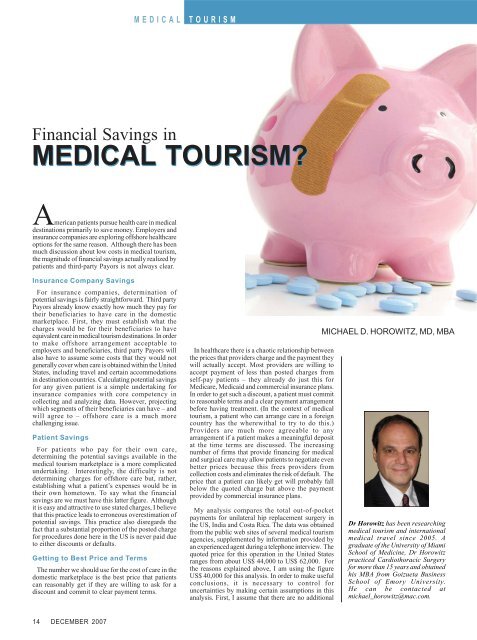Download PDF - Medical Tourism Magazine
Download PDF - Medical Tourism Magazine
Download PDF - Medical Tourism Magazine
You also want an ePaper? Increase the reach of your titles
YUMPU automatically turns print PDFs into web optimized ePapers that Google loves.
MEDICAL TOURISM<br />
Financial Savings in<br />
MEDICAL TOURISM?<br />
American patients pursue health care in medical<br />
destinations primarily to save money. Employers and<br />
insurance companies are exploring offshore healthcare<br />
options for the same reason. Although there has been<br />
much discussion about low costs in medical tourism,<br />
the magnitude of financial savings actually realized by<br />
patients and third-party Payors is not always clear.<br />
Insurance Company Savings<br />
For insurance companies, determination of<br />
potential savings is fairly straightforward. Third party<br />
Payors already know exactly how much they pay for<br />
their beneficiaries to have care in the domestic<br />
marketplace. First, they must establish what the<br />
charges would be for their beneficiaries to have<br />
equivalent care in medical tourism destinations. In order<br />
to make offshore arrangement acceptable to<br />
employers and beneficiaries, third party Payors will<br />
also have to assume some costs that they would not<br />
generally cover when care is obtained within the United<br />
States, including travel and certain accommodations<br />
in destination countries. Calculating potential savings<br />
for any given patient is a simple undertaking for<br />
insurance companies with core competency in<br />
collecting and analyzing data. However, projecting<br />
which segments of their beneficiaries can have – and<br />
will agree to – offshore care is a much more<br />
challenging issue.<br />
Patient Savings<br />
For patients who pay for their own care,<br />
determining the potential savings available in the<br />
medical tourism marketplace is a more complicated<br />
undertaking. Interestingly, the difficulty is not<br />
determining charges for offshore care but, rather,<br />
establishing what a patient’s expenses would be in<br />
their own hometown. To say what the financial<br />
savings are we must have this latter figure. Although<br />
it is easy and attractive to use stated charges, I believe<br />
that this practice leads to erroneous overestimation of<br />
potential savings. This practice also disregards the<br />
fact that a substantial proportion of the posted charge<br />
for procedures done here in the US is never paid due<br />
to either discounts or defaults.<br />
Getting to Best Price and Terms<br />
The number we should use for the cost of care in the<br />
domestic marketplace is the best price that patients<br />
can reasonably get if they are willing to ask for a<br />
discount and commit to clear payment terms.<br />
14 DECEMBER 2007<br />
In healthcare there is a chaotic relationship between<br />
the prices that providers charge and the payment they<br />
will actually accept. Most providers are willing to<br />
accept payment of less than posted charges from<br />
self-pay patients – they already do just this for<br />
Medicare, Medicaid and commercial insurance plans.<br />
In order to get such a discount, a patient must commit<br />
to reasonable terms and a clear payment arrangement<br />
before having treatment. (In the context of medical<br />
tourism, a patient who can arrange care in a foreign<br />
country has the wherewithal to try to do this.)<br />
Providers are much more agreeable to any<br />
arrangement if a patient makes a meaningful deposit<br />
at the time terms are discussed. The increasing<br />
number of firms that provide financing for medical<br />
and surgical care may allow patients to negotiate even<br />
better prices because this frees providers from<br />
collection costs and eliminates the risk of default. The<br />
price that a patient can likely get will probably fall<br />
below the quoted charge but above the payment<br />
provided by commercial insurance plans.<br />
My analysis compares the total out-of-pocket<br />
payments for unilateral hip replacement surgery in<br />
the US, India and Costa Rica. The data was obtained<br />
from the public web sites of several medical tourism<br />
agencies, supplemented by information provided by<br />
an experienced agent during a telephone interview. The<br />
quoted price for this operation in the United States<br />
ranges from about US$ 44,000 to US$ 62,000. For<br />
the reasons explained above, I am using the figure<br />
US$ 40,000 for this analysis. In order to make useful<br />
conclusions, it is necessary to control for<br />
uncertainties by making certain assumptions in this<br />
analysis. First, I assume that there are no additional<br />
MICHAEL D. HOROWITZ, MD, MBA<br />
Dr Horowitz has been researching<br />
medical tourism and international<br />
medical travel since 2005. A<br />
graduate of the University of Miami<br />
School of Medicine, Dr Horowitz<br />
practiced Cardiothoracic Surgery<br />
for more than 15 years and obtained<br />
his MBA from Goizueta Business<br />
School of Emory University.<br />
He can be contacted at<br />
michael_horowitz@mac.com.


